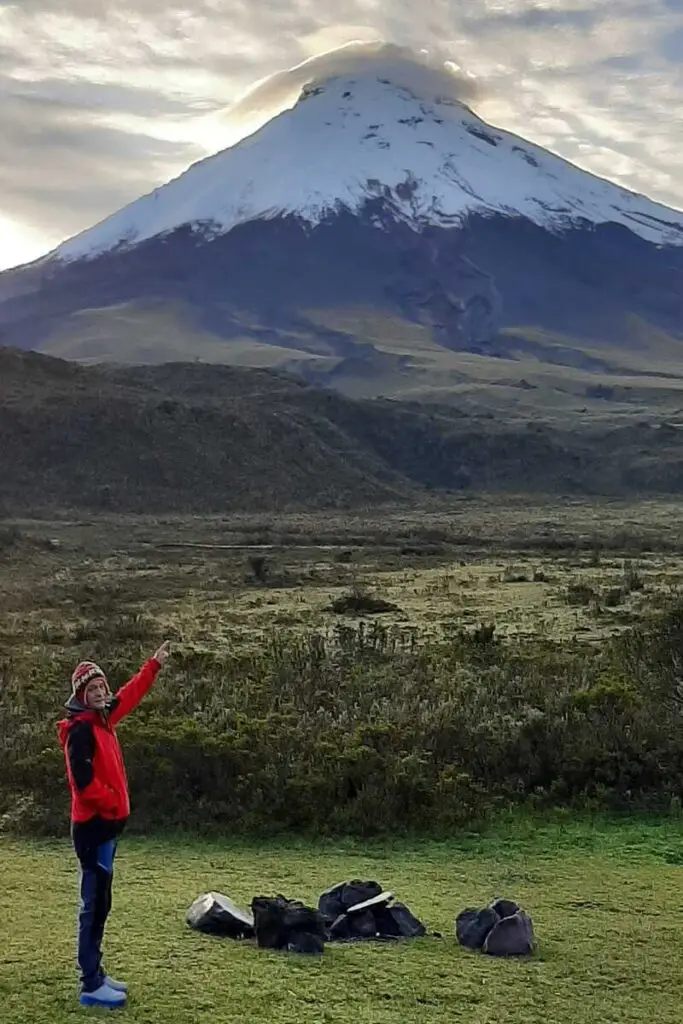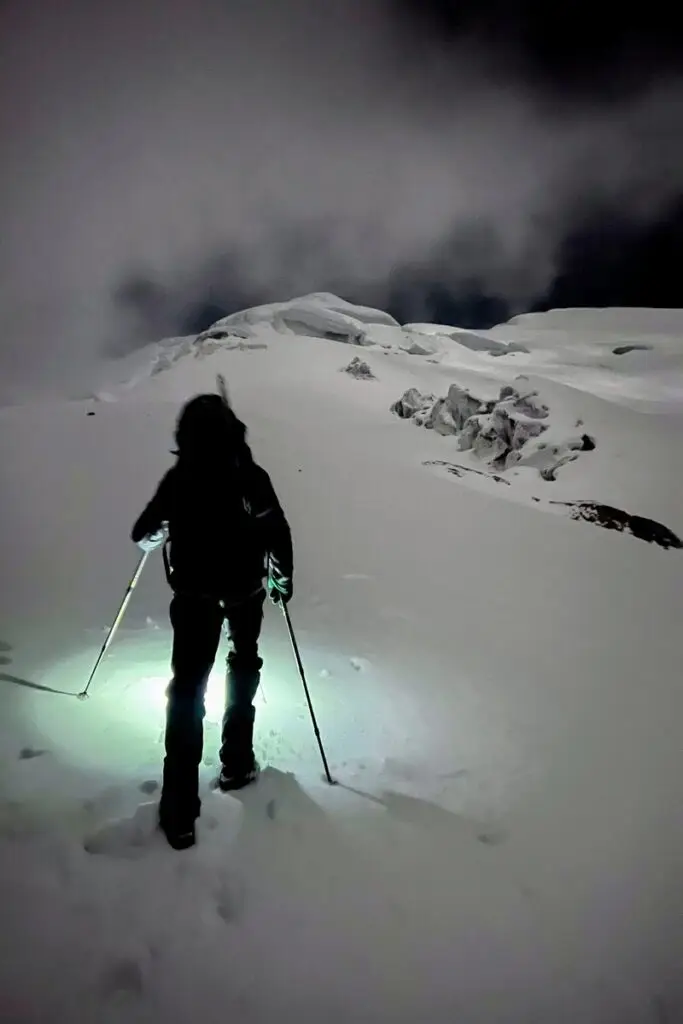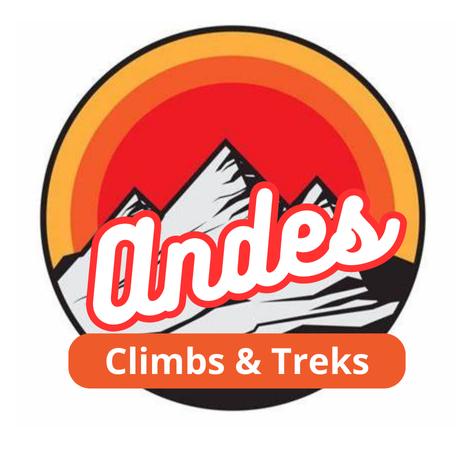

🌋 CLIMBING COTOPAXI and CHIMBORAZO
THE ULTIMATE ECUADOR MOUNTAINEERING EXPEDITION
With Two Itinerary Options: 8 or 10 Days
Climbing Cotopaxi and Chimborazo with proper acclimatization is one of the most rewarding mountaineering adventures in the Ecuadorian Andes. These two snowcapped giants are the highest peaks on the mainland of Ecuador, offering breathtaking beauty and an unforgettable high-altitude experience.
To give climbers the best chance of success, we offer two guided expedition options:
-
A classic 8-day program, ideal for climbers with limited time.
-
And a more robust 10-day itinerary, featuring an extended acclimatization phase that includes summiting Guagua and Ruco Pichincha, and Iliniza Norte (5,120 m).
Because acclimatization is essential for any high-altitude ascent, both itineraries are carefully designed to help your body gradually adjust above 4,200 meters. While the 8-day version offers an efficient and balanced progression, the 10-day program gives your body even more time to adapt, significantly increasing your comfort and performance during summit days.
The Cotopaxi climb, at 5,890 meters, is renowned for its perfect conical shape and stunning summit views. Located in the heart of Cotopaxi National Park, it remains one of the most iconic volcanoes in South America. From its summit, climbers can admire the vast crater, often steaming under crystal-clear skies.
The Chimborazo ascent, reaching 6,310 meters, is the ultimate highlight of this expedition. As the farthest point from the center of the Earth due to the planet’s equatorial bulge, Chimborazo presents both a physical and symbolic challenge. Although not overly technical, the climb demands endurance and proper preparation due to the cold, wind, and altitude. Thankfully, our certified Ecuadorian mountain guides ensure a safe and well-supported ascent.
💡 Why Choose Climbing Cotopaxi and Chimborazo Expedition?
✅ Gradual acclimatization program to optimize high-altitude performance.
✅ Certified Ecuador mountain guides with extensive experience on Cotopaxi and Chimborazo.
✅ Strategically designed itinerary, combining acclimatization hikes and gradual ascents.
✅ Spectacular views of the Ecuadorian Andes, valleys, and glaciers.
✅ Option to end in Baños, a subtropical town with hot springs and adventure activities.
📍 CLIMBING COTOPAXI and CHIMBORAZO
– 8 DAYS ITINERARY:
🗓️ Day 1: Quito – Pasochoa (4,250 m) – Quito
We begin our expedition with an early departure from Quito. After approximately two hours of driving, we arrive at the base of Pasochoa Volcano, where our first acclimatization hike takes place. This initial trek is crucial, as it enables your body to gradually and controlledly adapt to the altitude.
As we ascend, the trail takes us through the Andean páramo, a high-altitude ecosystem filled with native plants and birds. Moreover, the views along the way are spectacular, especially the panoramic lookouts toward Cotopaxi and the surrounding peaks. The hike to the summit of Pasochoa, at 4,250 meters, typically takes around three hours.
After enjoying the summit, we descend the same trail and return to Quito. Although this day involves moderate effort, it is essential for building a solid foundation for the climbs to come.
🗓️ Day 2: Quito – Ruco Pichincha (4,680 m) – Quito
On the second day, we continue the acclimatization process with a high-altitude hike to Ruco Pichincha. First, we take the Quito cable car, which brings us quickly up to 4,000 meters. From this point, the trail begins and gradually ascends to the summit at 4,680 meters.
Although the hike can be demanding at times, it rewards us with panoramic views of Quito and the surrounding Andes. In addition, some rocky sections offer a bit of a challenge, making it excellent training for the climbs ahead. The round-trip hike usually takes about five to six hours, including short breaks along the way.
After reaching the summit, we descend the same route and return to Quito. This day plays a crucial role in preparing your body for the altitude and physical effort required for Cotopaxi and Chimborazo.
🗓️ Day 3: Quito – Rumiñahui (4,650 m) – Cotopaxi Camp (3,900 m)
After breakfast in Quito, we drive south along the Pan-American Highway, which is also known as the Avenue of the Volcanoes, this time entering Cotopaxi National Park. The day’s objective is the Central Summit of Rumiñahui Volcano, which stands at 4,650 meters. This mountain is ideal for further acclimatization, offering both moderate challenge and excellent scenery.
The hike typically takes five to six hours round trip, with steady elevation gain that helps your body continue adapting to high altitude. Along the trail, you’ll pass through páramo grasslands and rocky ridges, while enjoying impressive views of Cotopaxi and the surrounding valleys.
Following the summit, we descend to our camp located at 3,900 meters. There, we settle in for the night, allowing for more altitude exposure in preparation for the Cotopaxi ascent. This day and night mark a key milestone in the acclimatization process.
🗓️ Day 4: Cotopaxi Refuge (4,864 m) – Glacier Training
After a restful night at camp, we begin the day with a short drive to the Cotopaxi parking area at 4,600 meters. From there, we hike for about 45 minutes to reach the José Rivas Refuge, located at 4,864 meters. This is where we’ll spend the night before the summit attempt.
In the afternoon, we conduct a glacier training session on the lower slopes of Cotopaxi. During this practical course, our certified mountain guides will review essential techniques such as walking in crampons, using an ice axe, and basic rope handling. These skills are not only important for safety but also increase your confidence on summit day.
After training, we return to the refuge, have an early dinner, and rest. Going to bed early is crucial, as the climb will begin shortly after midnight.
🗓️ Day 5: Cotopaxi Summit (5,890 m) – Riobamba
Summit day starts in the dark. Around midnight, we begin our climb toward Cotopaxi’s majestic summit. The route ascends steadily through snow and ice fields, guided by headlamp and supported by our experienced team. Thanks to the prior acclimatization and glacier training, you’ll be well prepared for the challenge.
The final section of the climb brings us to 5,890 meters, where we reach the crater rim of one of the world’s most impressive volcanoes. From the top, you’ll enjoy breathtaking 360° views of the Andes under the rising sun.
After taking in the summit views and celebrating your achievement, we descend back to the refuge for breakfast. Later in the morning, we drive to Riobamba, a strategic location before the Chimborazo ascent, where we stay overnight and prepare for the next big climb.
🗓️ Day 6: Riobamba – Chimborazo Base Camp (3,900 m)
Today offers a slower pace, allowing you to rest and maintain your acclimatization. After breakfast, a short city stop, and lunch in Riobamba, we head to Chimborazo’s southern base, driving approximately one hour to reach our campsite at 3,900 meters.
This base camp offers stunning views of Chimborazo and its surroundings. In the afternoon, you can relax, review your gear, and prepare mentally for the days ahead. A hearty dinner and early bedtime help set the stage for the next step of your ascent.
🗓️ Day 7: Chimborazo – Carrel Refuge (4,800 m) or High Camp (5,200 m)
Depending on your program choice, today includes two possible options. Most groups hike from base camp to the Carrel Refuge at 4,800 meters, which is accessible via a short vehicle transfer, too. This is the classic route, allowing for rest and minimal exertion before the summit push.
Alternatively, experienced climbers may choose to ascend higher and sleep at the high camp at 5,200 meters, located near the “ Castillo.” This option requires participants to carry their gear, including a sleeping bag, and involves an additional cost. However, it offers a shorter summit night and a quieter experience on the mountain.
Both options are excellent, and your guide will help you decide based on conditions and group readiness. After an early dinner, you’ll rest and prepare for the midnight climb.
🗓️ Day 8: Chimborazo Summit (6,310 m) – Return to Quito or Baños
Just before midnight, we begin the final ascent of Chimborazo. Using technical equipment such as crampons, helmet, and ice axe, we follow the Cresta del Castillo route, which leads us steadily upward through snow and mixed terrain.
At sunrise, we get to the summit of Chimborazo, at 6,310 meters, the farthest point from the center of the Earth due to the planet’s equatorial bulge. Reaching this altitude is an incredible accomplishment and provides unbeatable 360-degree views of the Ecuadorian Andes.
After summiting, we descend carefully to the refuge, enjoy a celebratory breakfast, and pack our equipment. Depending on your plan, we either return to Quito or head to the town of Baños, a vibrant destination known for hot springs and adventure activities.
📍 CLIMBING COTOPAXI and CHIMBORAZO
– 10 DAYS ITINERARY:
🗓️ Day 1: Quito – Pasochoa (4,250 m)
We begin our expedition with an early departure from Quito, driving for approximately two hours toward the Pasochoa Wildlife Reserve. This extinct volcano is an ideal location to start the acclimatization process, thanks to its moderate elevation and beautiful Andean surroundings.
At an altitude of around 3,600 meters, the trail begins with a gentle ascent through páramo grasslands and native forest. As we gain elevation, the views open up toward the Avenue of the Volcanoes. After three hours of steady hiking, we reach the summit of Pasochoa at 4,250 meters. From this vantage point, you’ll enjoy sweeping panoramas of Cotopaxi and nearby peaks.
Later, we descend for about two hours and return to Quito, where we spend the night and prepare for the next day’s high-altitude adventure.
🗓️ Day 2: Quito – Guagua Pichincha (4,790 m) – High Camp (4,000 m)
On day two, we continue acclimatizing with an ascent of Guagua Pichincha, one of the most accessible high peaks near Quito. After a short drive, we reach the starting point at 4,000 meters. From here, the trail leads us up toward the crater rim.
The hike takes about three hours and rewards us with a close-up look at this active volcano, along with expansive views of Quito and the surrounding Andean highlands. Once we summit at 4,790 meters, we take time to rest, take photos, and enjoy the unique volcanic environment.
After descending, we head to a nearby high camp at 4,000 meters, where we enjoy a warm dinner and a restful night. Spending the night at this altitude is a key step in your gradual acclimatization.
🗓️ Day 3: Ruco Pichincha (4,670 m) – Return to Quito
Following breakfast at camp, we lace up our boots for a longer and more demanding hike to Ruco Pichincha. The route starts in a broad alpine valley and slowly gains elevation as we approach rocky terrain and steeper sections.
After approximately seven hours of hiking, we reach the summit of Ruco Pichincha at 4,670 meters. Along the way, we take short breaks to hydrate, enjoy high-altitude snacks, and admire the landscape. The summit offers a commanding view of the Andes and the valleys below.
In the afternoon, we descend and transfer back to Quito. This extended hiking day plays a significant role in pushing your acclimatization forward, while also allowing for a good night’s rest in the city.
🗓️ Day 4: Quito – Ilinizas Refuge (4,650 m)
Today marks the transition from preparation hikes to actual climbs. After an early breakfast in Quito, we make final gear checks and begin the drive south to the Ilinizas Ecological Reserve. Our goal is the “La Virgen” parking area, located at 3,900 meters.
From there, we hike for around three hours to reach the Ilinizas Refuge at 4,650 meters. The trail climbs gradually through moorlands and rocky outcrops, giving your body more time to adapt to thinner air. Once at the refuge, we settle in, enjoy a nourishing dinner, and rest in preparation for the Iliniza Norte ascent.
🗓️ Day 5: Iliniza Norte Summit (5,120 m) – Cotopaxi National Park Camp (3,900 m)
Summit day begins before dawn. At around 5:00 am, we leave the refuge and begin our climb along the rugged ridge that leads to the summit of Iliniza Norte. The ascent typically takes about four hours and involves some scrambling, adding a bit of adventure to your acclimatization journey.
Once at the summit (5,120 m), we celebrate with photos and take in the impressive views of Cotopaxi, Chimborazo, and the surrounding Andes. Afterward, we descend carefully back to the parking area.
In the afternoon, we transfer to Cotopaxi National Park and set up camp at 3,900 meters. Here, you’ll enjoy a peaceful evening with a spectacular sunset over Cotopaxi’s snowcapped cone. Dinner is served at camp, and the night at altitude further reinforces your adaptation.
🗓️ Day 6: Cotopaxi Refuge (4,864 m) – Glacier Training
After a restful night at camp, we begin the day with a short drive to the Cotopaxi parking area at 4,600 meters. From there, we hike for about 45 minutes to reach the José Rivas Refuge, located at 4,864 meters. This is where we’ll spend the night before the summit attempt.
In the afternoon, we conduct a glacier training session on the lower slopes of Cotopaxi. During this practical course, our certified mountain guides will review essential techniques such as walking in crampons, using an ice axe, and basic rope handling. These skills are not only important for safety but also increase your confidence on summit day.
After training, we return to the refuge, have an early dinner, and rest. Going to bed early is crucial, as the climb will begin shortly after midnight.
🗓️ Day 7: Cotopaxi Summit (5,890 m) – Riobamba
Summit day starts in the dark. Around midnight, we begin our climb toward Cotopaxi’s majestic summit. The route ascends steadily through snow and ice fields, guided by headlamp and supported by our experienced team. Thanks to the prior acclimatization and glacier training, you’ll be well prepared for the challenge.
The final section of the climb brings us to 5,890 meters, where we reach the crater rim of one of the world’s most impressive volcanoes. From the top, you’ll enjoy breathtaking 360° views of the Andes under the rising sun.
After taking in the summit views and celebrating your achievement, we descend back to the refuge for breakfast. Later in the morning, we drive to Riobamba, a strategic location before the Chimborazo ascent, where we stay overnight and prepare for the next big climb.
🗓️ Day 8: Riobamba – Chimborazo Base Camp (3,900 m)
Today offers a slower pace, allowing you to rest and maintain your acclimatization. After breakfast, a short city stop, and lunch in Riobamba, we head to Chimborazo’s southern base, driving approximately one hour to reach our campsite at 3,900 meters.
This base camp offers stunning views of Chimborazo and its surroundings. In the afternoon, you can relax, review your gear, and prepare mentally for the days ahead. A hearty dinner and early bedtime help set the stage for the next step of your ascent.
🗓️ Day 9: Chimborazo – Carrel Refuge (4,800 m) or High Camp (5,200 m)
Depending on your program choice, today includes two possible options. Most groups hike from base camp to the Carrel Refuge at 4,800 meters, which is accessible via a short vehicle transfer, too. This is the classic route, allowing for rest and minimal exertion before the summit push.
Alternatively, experienced climbers may choose to ascend higher and sleep at the high camp at 5,200 meters, located near the “ Castillo.” This option requires participants to carry their gear, including a sleeping bag, and involves an additional cost. However, it offers a shorter summit night and a quieter experience on the mountain.
Both options are excellent, and your guide will help you decide based on conditions and group readiness. After an early dinner, you’ll rest and prepare for the midnight climb.
🗓️ Day 10: Chimborazo Summit (6,310 m) – Return to Quito or Baños
Just before midnight, we begin the final ascent of Chimborazo. Using technical equipment such as crampons, a helmet, and an ice axe, we follow the Cresta del Castillo route, which leads us steadily upward through snow and mixed terrain.
At sunrise, we get to the summit of Chimborazo, at 6,310 meters, the farthest point from the center of the Earth due to the planet’s equatorial bulge. Reaching this altitude is an incredible accomplishment and provides unbeatable 360-degree views of the Ecuadorian Andes.
After summiting, we descend carefully to the refuge, enjoy a celebratory breakfast, and pack our equipment. Depending on your plan, we either return to Quito or head to the town of Baños, a vibrant destination known for hot springs and adventure activities.
✅ CLIMBING COTOPAXI and CHIMBORAZO – TOUR SUMMARY
✔️ Duration: 8 days / 7 nights
✔️ Maximum altitude: 6,310 m (Chimborazo Summit)
✔️ Difficulty: High (requires good physical condition and prior acclimatization)
✔️ Best season: June – August / December – February
✔️ Includes: Certified Mountain guides, accommodation, meals, technical equipment, private transportation
